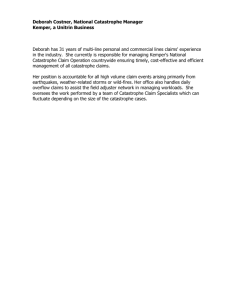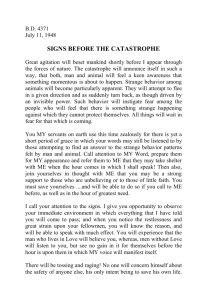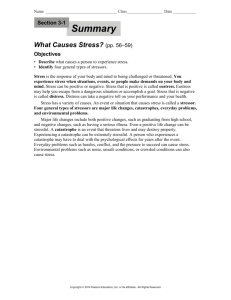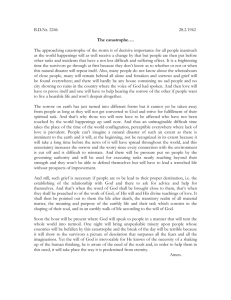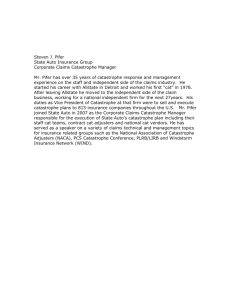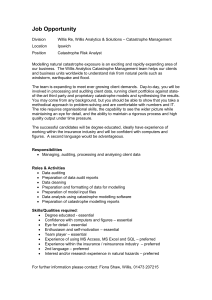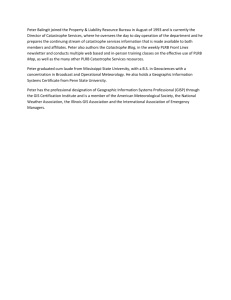Session Ten Lecture Notes: Television, Reality, Culpability Professor Eugenie Brinkema -
advertisement
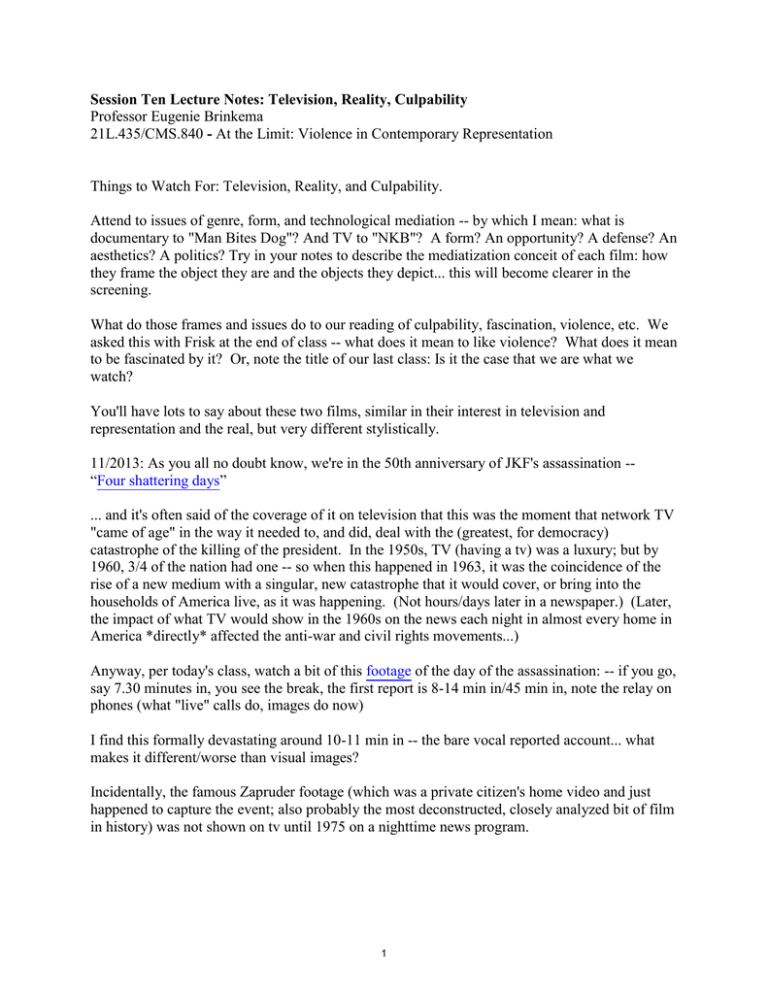
Session Ten Lecture Notes: Television, Reality, Culpability Professor Eugenie Brinkema 21L.435/CMS.840 - At the Limit: Violence in Contemporary Representation Things to Watch For: Television, Reality, and Culpability. Attend to issues of genre, form, and technological mediation -- by which I mean: what is documentary to "Man Bites Dog"? And TV to "NKB"? A form? An opportunity? A defense? An aesthetics? A politics? Try in your notes to describe the mediatization conceit of each film: how they frame the object they are and the objects they depict... this will become clearer in the screening. What do those frames and issues do to our reading of culpability, fascination, violence, etc. We asked this with Frisk at the end of class -- what does it mean to like violence? What does it mean to be fascinated by it? Or, note the title of our last class: Is it the case that we are what we watch? You'll have lots to say about these two films, similar in their interest in television and representation and the real, but very different stylistically. 11/2013: As you all no doubt know, we're in the 50th anniversary of JKF's assassination -“Four shattering days” ... and it's often said of the coverage of it on television that this was the moment that network TV "came of age" in the way it needed to, and did, deal with the (greatest, for democracy) catastrophe of the killing of the president. In the 1950s, TV (having a tv) was a luxury; but by 1960, 3/4 of the nation had one -- so when this happened in 1963, it was the coincidence of the rise of a new medium with a singular, new catastrophe that it would cover, or bring into the households of America live, as it was happening. (Not hours/days later in a newspaper.) (Later, the impact of what TV would show in the 1960s on the news each night in almost every home in America *directly* affected the anti-war and civil rights movements...) Anyway, per today's class, watch a bit of this footage of the day of the assassination: -- if you go, say 7.30 minutes in, you see the break, the first report is 8-14 min in/45 min in, note the relay on phones (what "live" calls do, images do now) I find this formally devastating around 10-11 min in -- the bare vocal reported account... what makes it different/worse than visual images? Incidentally, the famous Zapruder footage (which was a private citizen's home video and just happened to capture the event; also probably the most deconstructed, closely analyzed bit of film in history) was not shown on tv until 1975 on a nighttime news program. 1 Natural Born Killers, 1994: Mickey, Mallory, Jack Scagnetti, Wayne Gale Man Bites Dog: 1992, Ben, Remy, etc. Liveness/Information, Catastrophe, Crisis (lure of referentiality – the Real) “the eternal dead-again of the cinema” = re-morts, pun on re-mords (remorse) Today, we start the final section of our course: a four-week focus on postmodern media, mediation, remediation, and related terms including: immediacy, television, reality TV, liveness, news media culpability, celebrity, involvement, documentary form. We have two films today that are about violence and media that are themselves examples of violent media (and I do mean example in the sense of a sample or particular case and also exemplary, the privileged case – they both exemplify as in typify violence and also themselves were invoked as bad examples of media violence as texts), and both have been charged with the accusation that they will or have prompted copycat “real” incidences of violence (NBK; Stone and Time Warner were sued by people including John Grisham… “product liability”/dismissed). Not unlike our first class on Rolling Stone cover, we’re back to issues of media bleed between the real and representation – with violence, never quite leave that issue… British Film Board delayed NBK release b/c of controversy Today, we’re looking at Man Bites Dog and Natural Born Killers; next week, we’ll talk about issues of the graphic, the comic and cartoonish, and both weeks we’ll address postmodern formal issues. As we move towards the more meta- of our last few weeks, asking the essential question: Is it the case that we are what we see, I see this week as posing a preliminary version of that question: Is it the case that we are what we document? Put another way, does documentation always lead to participation or collusion? Or, yet another way: what is the relationship between, and is there a crucial difference between being an observer and being a participant? One final way: what does it mean to profit from violence? Quick and dirty overview of a few key concepts in theorizing television: Major category of TV is time (not space, as in cinema) liveness, present-ness, “This-is-going-on” noeme (status of the “Live” Interview in NBK) promise of presence/immediacy offered by video liveness aligns televisual discourse with “the real” TV organizes itself around the event; sometimes happens to fill that time In the media event “the referent becomes indissociable from the medium”—what TV is covering in the media event is, in large part, that TV is covering the media event (i.e. a reporter in harm in a war zone is the subject of the broadcast; Anderson Cooper’s body in the covering of the hurricane) Three organizations of temporality, produce three ways of apprehending the event: 2 Information: steady stream of daily, noteworthy events. It is always there; and it is everywhere (not just on the news, but on other programs: therapeutic, scientific, etc.). Time here is flowing and continuous…and full; this is what TV time is mostly made of: forgettable, daily, pervasive “noise.” One risk (or, others might say, one advantage) of all this information is a leveling out, a banalization of information. But dramatic forms can allow for certain pieces of information to be privileged or hierarchized. Catastrophe: this temporal category is marked by the instant, the moment, the punctual an “unexpected discontinuity in an otherwise continuous system.” The catastrophe is a catastrophe is large part because it is so sudden: its disruption is a temporal disruption. “It happened so fast!”/“It happened too fast.” We can’t catch up to catastrophe: the moment we realize it’s happening, it’s already happened. The category of catastrophe poses a problem for TV theorists: to the extent that it’s a discontinuity, and to the extent that TV is often described as a system of nothing but discontinuities—we have to ask: is everything on TV a catastrophe… or, is nothing on TV a catastrophe? Catastrophe is linked to the idea of Progress, development, historical linearity—the onward march of humankind’s triumph over the chaotic natural world. At the moment of the catastrophe itself, Doane writes that “time stands still”—catastrophe signals a failure of that progress, a halting in that forward march. At the same time, televisual coverage of catastrophe bears witness to this pause and thus, in its repetition of footage, re-enlivens that stillness, attempts to get things going again. Crisis: Crisis is marked by condensed time; it demands resolution: think, a hostage crisis, a political coup, Waco, Columbine; while catastrophe and information are “subject-less”, Doane writes, crisis is “attributed to a subject” Television holds out the lure of referentiality in its coverage of catastrophe: in that instant, caught live, played and replayed, TV seems to promise something beyond mediation— something like the referent itself, the incontrovertibly real. Death, and trauma more generally, viewed as markers of something “real.” So, Death functions as a sort of relay in televisual discourse: death appears to be the thing that exceeds representation (that mark of the real), but it is also pushed away from us precisely by representation. In the age of media, in the West in particular, death is largely something that we experience at a remove: instead of the smells and sounds of death, images—of bodies in pain, of people dying in war—are largely images at a distance, images through a screen. Pose the question: what is at stake in our desire to have access to the referential? Why is it that we want TV or any medium to fill in that “missed encounter”? TO bring us the live event, as it is happening, unfiltered, unedited, in the real? These Films: 1992, 1994 = anxiety about rise of reality television Anxiety about the positing of violence as the sign/marker of the Real 3 MIT OpenCourseWare http://ocw.mit.edu CMS.840 / 21L.435 At the Limit: Violence in Contemporary Representation Fall 2013 For information about citing these materials or our Terms of Use, visit: http://ocw.mit.edu/terms.
